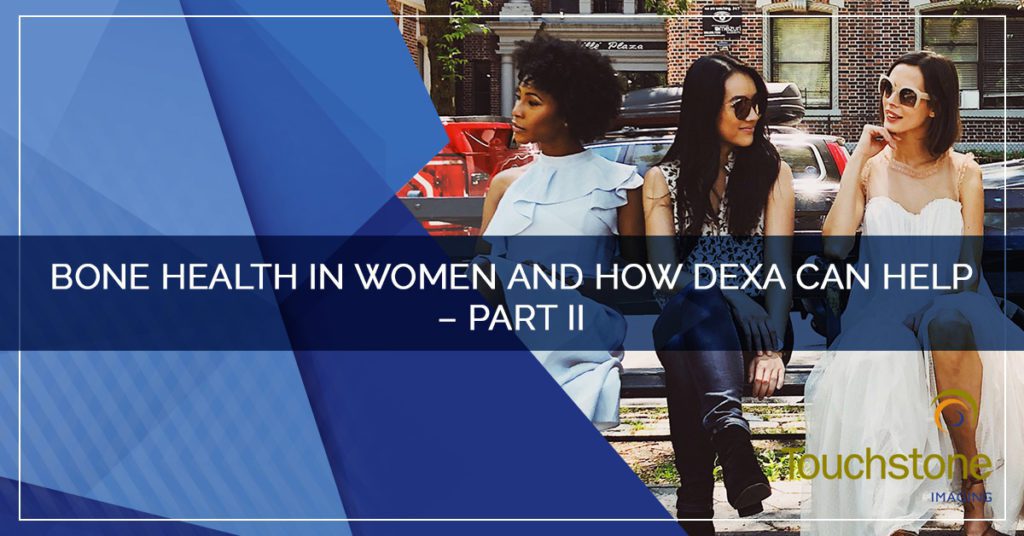In our last post, we touched on why women tend to have lower bone density levels as they age and why bone density DEXA is important. In today’s post, we’ll dive into how a bone density DEXA is evaluated and read, and factors that help promote healthy bone density levels.
At Touchstone imaging, we want you to live your best life, that’s why we offer a full range of women’s imaging services, including bone density DEXA scan. Find answers about your bone density results at one of our imaging centers. Follow along today for ways to support your bones and prevent further bone loss.
What bone density results look like
After a bone density DEXA is performed, your results come in the form of T-scores and Z-scores.
- T-score – The t-score evaluates the person’s bone density with that of a healthy 30-year old of the same sex.
- Z-score – The z-score evaluates a person’s bone density with that of a person of the same age and sex.
The easiest interpretation is that the lower the T- or Z-score, the lower your bone density is. For example:
- A T-score of -2.5 and lower, indicates osteoporosis.
- A T-score of -1.0 to -2.5 can indicate osteopenia which is below normal bone density, but not quite yet osteoporosis.
If you have a bone density DEXA and scans indicate bone loss, there are things you can do to support healthy bone density levels and reduce further bone loss.
Nutrients That Support Bones
Many women think taking a calcium supplement is enough to combat bone loss, and while it is helpful, there are many other beautiful and bone-supporting nutrients you can take.
- Vitamin K – Many people aren’t familiar with the bone-supporting nutrient vitamin K. What makes this nutrient crucial for bone support, is its ability to guide and direct calcium to the bones while keeping it from the arteries. Find vitamin K in health food stores or naturally in dark leafy greens such as kale or spinach.
- Vitamin D – Many of us are deficient in vitamin D so getting enough in critical for proper calcium absorption. You can get vitamin D directly from the sun or through supplements.
Additional nutrients that support the bones are iron, vitamin C, and magnesium. Iron is imperative in its role in collagen production and how vitamin D is metabolized. Vitamin C stimulates collagen and prompts the cells that build bones, aids in calcium absorption, and assists in proper vitamin D function.
An alkaline diet supports bones so eating a diet rich in vegetables, fruit, and protein while avoiding overly processed, high sugar, and high sodium foods.
Movement That Supports Bones
It seems counterintuitive, but specific types of movement greatly support bones. To both create and keep strong bones, weight-bearing exercises are the most beneficial. Weight-bearing exercise refers to anything that creates a force against gravity, so this can be running, dancing, playing tennis or basketball, or high interval intensity training. It’s important to stay consistent and move at least three to four times a week for at least 30 minutes. Additionally, weight training is beneficial and you can incorporate it into your normal work out days, or do it at least three days per week. Exercise is also great for balancing hormones and maintaining a healthy body weight.
Lifestyle Choices that Support Bones
It’s also important to note that keeping a healthy weight to prevent obesity not only is hormone balancing and supports healthy inflammation levels, but it is also advantageous to your bones. It not only helps you stay active but makes it easier to continue on a healthy path as you age.
Getting enough sleep not only helps you maintain a healthy weight and supports your immune system but it is also essential in regulating hormones, namely estrogen in women. Make sure you’re getting between five to nine hours (everyone is different) to get all the benefits of a proper night’s sleep.
Quitting smoking addresses a myriad of health-related issues, but many research studies have found that smoking increases your risk of bone fractures and osteoporosis. Women who do smoke tend to go through menopause at an earlier age and may have other risk factors such as a smaller body frame and poor diets.
When you get a bone density DEXA scan it can be confusing on what the data reveals, so recognizing your T-score and Z-score can help you get a better understanding of your results. If you’re in a position where you need to increase your bone density or prevent it from further decline, there are nutrients and movement that help promote bone health. In addition, there are also lifestyle factors and choice you can make to support your overall bone health.
At Touchstone Imaging, identifying thinning bones and diseases such as osteoporosis and osteopenia is done through our state-of-art imaging, such as the bone density DEXA. We’ll take a snapshot of your bone mass in your hips, wrists, and spine to help evaluate your bone mass. Learn about our full range of women’s imaging services here. Schedule your appointment today!



